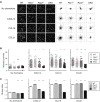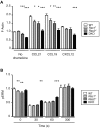Critical roles for Rac GTPases in T-cell migration to and within lymph nodes
- PMID: 20870900
- PMCID: PMC3368586
- DOI: 10.1182/blood-2010-08-299438
Critical roles for Rac GTPases in T-cell migration to and within lymph nodes
Abstract
Naive T cells continuously recirculate between secondary lymphoid tissue via the blood and lymphatic systems, a process that maximizes the chances of an encounter between a T cell and its cognate antigen. This recirculation depends on signals from chemokine receptors, integrins, and the sphingosine-1-phosphate receptor. The authors of previous studies in other cell types have shown that Rac GTPases transduce signals leading to cell migration and adhesion; however, their roles in T cells are unknown. By using both 3-dimensional intravital and in vitro approaches, we show that Rac1- and Rac2-deficient T cells have multiple defects in this recirculation process. Rac-deficient T cells home very inefficiently to lymph nodes and the white pulp of the spleen, show reduced interstitial migration within lymph node parenchyma, and are defective in egress from lymph nodes. These mutant T cells show defective chemokine-induced chemotaxis, chemokinesis, and adhesion to integrin ligands. They have reduced lateral motility on endothelial cells and transmigrate in-efficiently. These multiple defects stem from critical roles for Rac1 and Rac2 in transducing chemokine and sphingosine-1-phosphate receptor 1 signals leading to motility and adhesion.
Figures







Similar articles
-
A novel Rac-dependent checkpoint in B cell development controls entry into the splenic white pulp and cell survival.J Exp Med. 2010 Apr 12;207(4):837-53. doi: 10.1084/jem.20091489. Epub 2010 Mar 22. J Exp Med. 2010. PMID: 20308364 Free PMC article.
-
Rac GTPase isoforms Rac1 and Rac2 play a redundant and crucial role in T-cell development.Blood. 2008 Sep 1;112(5):1767-75. doi: 10.1182/blood-2008-01-132068. Epub 2008 Jun 25. Blood. 2008. PMID: 18579797 Free PMC article.
-
Rac1 and Rac2 regulate macrophage morphology but are not essential for migration.J Cell Sci. 2006 Jul 1;119(Pt 13):2749-57. doi: 10.1242/jcs.03024. Epub 2006 Jun 13. J Cell Sci. 2006. PMID: 16772332
-
The role of chemokine activation of Rac GTPases in hematopoietic stem cell marrow homing, retention, and peripheral mobilization.Exp Hematol. 2006 Aug;34(8):976-85. doi: 10.1016/j.exphem.2006.03.016. Exp Hematol. 2006. PMID: 16863904 Review.
-
T cell migration dynamics within lymph nodes during steady state: an overview of extracellular and intracellular factors influencing the basal intranodal T cell motility.Curr Top Microbiol Immunol. 2009;334:71-105. doi: 10.1007/978-3-540-93864-4_4. Curr Top Microbiol Immunol. 2009. PMID: 19521682 Review.
Cited by
-
HIV-1 Nef interferes with T-lymphocyte circulation through confined environments in vivo.Proc Natl Acad Sci U S A. 2012 Nov 6;109(45):18541-6. doi: 10.1073/pnas.1204322109. Epub 2012 Oct 23. Proc Natl Acad Sci U S A. 2012. PMID: 23093676 Free PMC article.
-
Tyrosine kinases EnAbling adaptor molecules for chemokine-induced Rap1 activation in T cells.Sci Signal. 2012 Jul 31;5(235):pe33. doi: 10.1126/scisignal.2003383. Sci Signal. 2012. PMID: 22855504 Free PMC article.
-
Combined Immunodeficiency Caused by a Novel De Novo Gain-of-Function RAC2 Mutation.J Clin Immunol. 2022 Aug;42(6):1280-1292. doi: 10.1007/s10875-022-01288-4. Epub 2022 May 21. J Clin Immunol. 2022. PMID: 35596857
-
RHO GTPases: from new partners to complex immune syndromes.Nat Rev Immunol. 2021 Aug;21(8):499-513. doi: 10.1038/s41577-021-00500-7. Epub 2021 Feb 5. Nat Rev Immunol. 2021. PMID: 33547421 Review.
-
Kurarinone regulates Th17/Treg balance and ameliorates autoimmune uveitis via Rac1 inhibition.J Adv Res. 2025 Mar;69:381-398. doi: 10.1016/j.jare.2024.03.013. Epub 2024 Mar 24. J Adv Res. 2025. PMID: 38522752 Free PMC article.
References
-
- Bromley SK, Mempel TR, Luster AD. Orchestrating the orchestrators: chemokines in control of T cell traffic. Nat Immunol. 2008;9(9):970–980. - PubMed
-
- Okada T, Cyster JG. CC chemokine receptor 7 contributes to Gi-dependent T cell motility in the lymph node. J Immunol. 2007;178(5):2973–2978. - PubMed
-
- Huang JH, Cardenas-Navia LI, Caldwell CC, et al. Requirements for T lymphocyte migration in explanted lymph nodes. J Immunol. 2007;178(12):7747–7755. - PubMed
Publication types
MeSH terms
Substances
LinkOut - more resources
Full Text Sources
Other Literature Sources
Molecular Biology Databases
Research Materials
Miscellaneous

